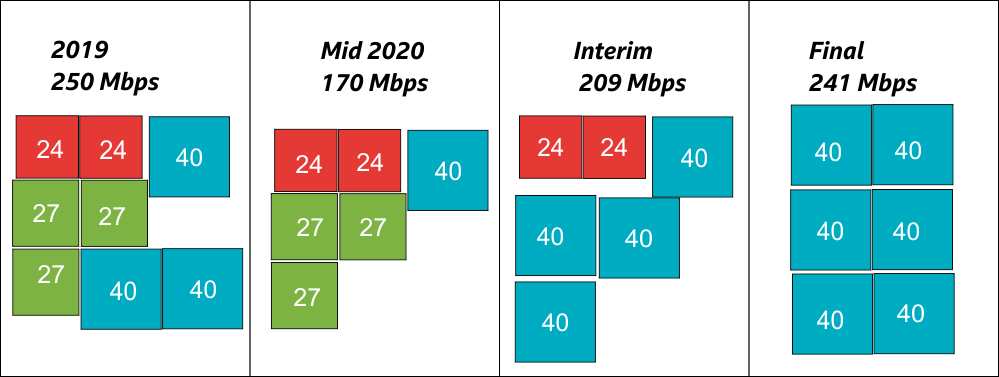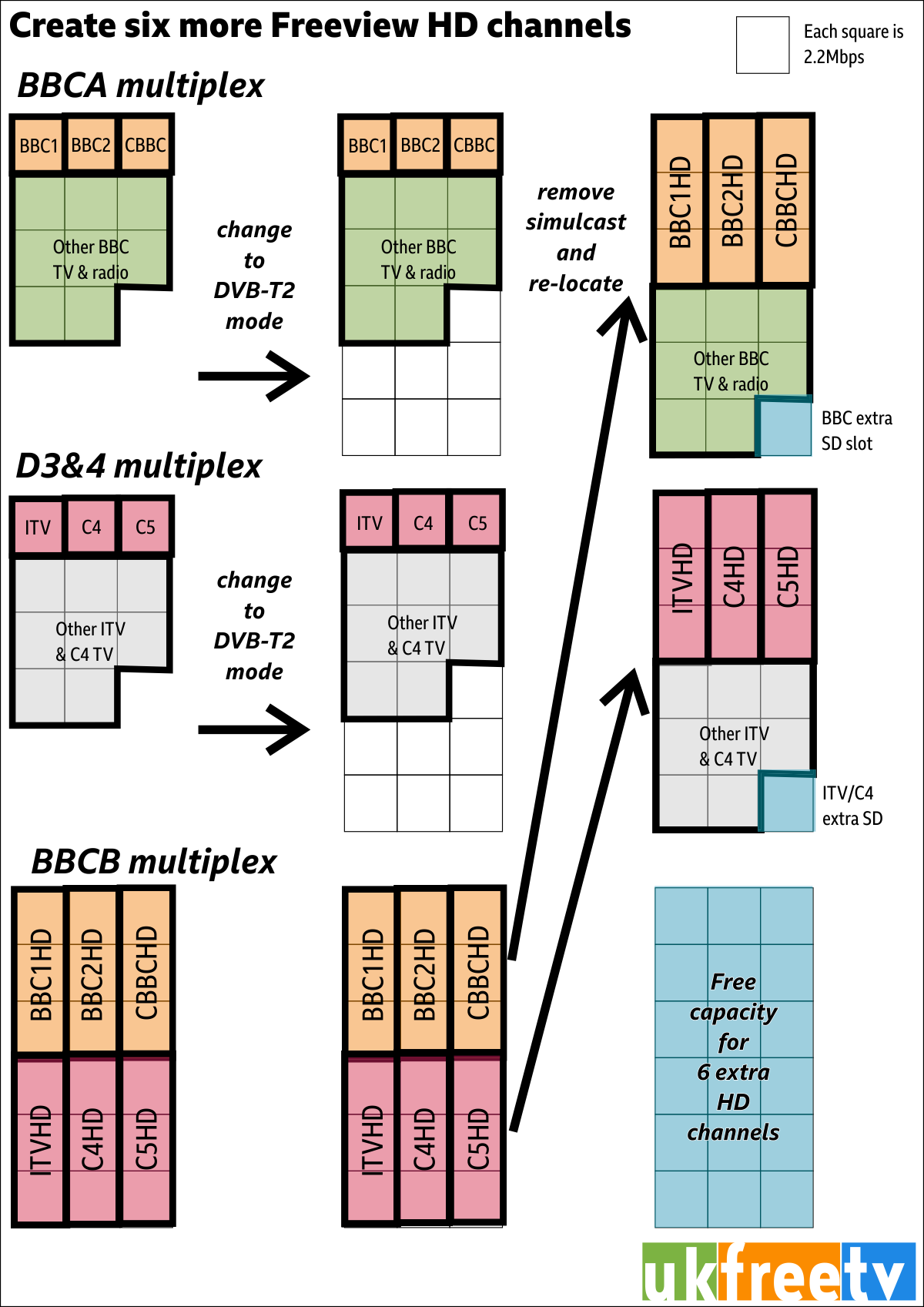Rebuilding Freeview High Definition from 2019 onwards

As Freeview High Definition users in Cornwall already know, the number of TV channels being broadcast in the UK will be cut back in mid-2020 to make way for the fifth generation of mobile phone data services.
This is because the number of multiplexes being broadcast will be cut back to the original six. The extra two were provided as a “interim service”. A Freeview multiplex is a single broadcast of binary data that occupies a 8MHz frequency range. In the UK each of these can carry 24.1, 27.1 or 40.2Mbps or of data.
Because older TV sets and set-top boxes can only work with 24.1 Mbps, it is only possible for the owners of the multiplexes to use the higher capacity modes when every home has switched to Freeview HD capable equipment. This equipment is marked with “DVB-T2”.
As illustrated, the total bitrate (in a home that can receive all the multiplexes) will change over time.

Meet the multiplexes
Not all the multiplexes are the same:
- only three are broadcast to the whole of the UK;
- a different three are broadcast in the better DVB-T2 mode;
- legally, only BBC channels may appear on BBCA
- also, legally, only public service broadcast channels (ITV, C4, C5) can appear on D3&4
- The HD mode multiplexes have more bits and use a more video efficient encoding system (MPEG-4)
- The current license to broadcast have different end-dates
This can be summaries in this table.
|
Multiplex name |
Expires |
HD mode? |
Coverage |
Mode |
Bitrate today |
||
|
com7 |
21 June 2020 |
Yes |
76% |
6 |
40.2 |
||
|
com8 |
21 June 2020 |
Yes |
76% |
6 |
40.2 |
||
|
D3&4 |
15 November 2022 |
No |
100% |
3 |
24.1 |
||
|
ARQA |
15 November 2026 |
No |
90% |
8 |
27.1 |
||
|
ARQB |
15 November 2026 |
No |
90% |
8 |
27.1 |
||
|
SDN |
15 November 2026 |
No |
90% |
8 |
27.1 |
||
|
BBCB |
16 November 2026 |
Yes |
100% |
6 |
40.2 |
||
|
BBCA |
31 December 2027 |
No |
100% |
3 |
24.1 |
Freeview requires about 2.2Mbps for a standard definition channels and three times that for a high definition one (6.7Mbps).
The Freeview HD EPG problem
One problem for people with Freeview HD receivers will note is that HD channels are grouped together in the program guide, rather than appear as replacements for the standard definition channels as viewers expect. This is because the six channels on the BBCB multiplex (BBC One, BBC Two, CBBC, ITV, Channel 4 and Channel 5) can only be seen on newer boxes, making channel number replacement impossible without breaking the oldest Freeview equipment.
Basically the UK-wide BBCA and D3&4 multiplexes can’t change mode until ALL homes can receive them.
The interim position
There is good news, however, for the SDN, ARQA and ARQB multiplexes. They can switch modes to the high definition whenever they feel that it is commercially practical. This might be at a lower level of Freeview HD box use, perhaps 80% or 90%.
By switching to DVB-T2 mode, each of them can increase their capacity from 27.1 to 40.2Mbps and take advantage of MPEG4.
.png)
So, of the 80Mbps lost when com7 and com8 close, half of that can be got back by SDN, ARQA and ARQB upgrading, which would be enough for an extra 6 full HD services.
The HD public service channels
This diagram explains what will happen to create space six more Freeview HD channels.

The gains for the BBC when everyone has a DVB-T2 receiver are larger. It will:
- No longer need half of the capacity on the BBCB multiplex (20.1Mbps) as it can move these channels to BBCA
- Gain 16.1 Mbps on BBCA due to the mode change;
- Gain 6.6 Mbps from not simulcasting three services in SD and HD
- Use the “gained 22.1Mbps” Be able to supply all the BBC television channels in HD to all UK homes
For the D3&4 multiplex, the gains are similar:
- No longer need the 20.1Mbps on BBCB, making it available for other UK-wide services.
- Gain 16.1 Mbps on D3&4 due to the mode change;
- Gain 6.6 Mbps from not simulcasting three services in SD and HD
- Be able to broadcast ITV, C4 and C5 in HD to all UK homes
I hope that's as clear as possible! Any qestions?
12:39 PM
David Warner:
You need to sort out your COM7 reception. You have not provided any feedback to the comments and suggestions to the variety of posts you've made recently.
| link to this comment |
5:27 PM
There's been a lot of out-of-date, poor and mis-information around about COMs 7&8. Here is a prcis of the current situation -
OFCOM have updated the Arqiva licence for COMs 7&8 to be consistent with the forthcoming auction of the 700MHz frequencies (date TBD). Whichever MNOs (if any) buy the centre frequencies in which these two muxes reside, then they may give 3 months notice for closure, or there's an endstop date of 30th June 2022 whichever is sooner.
See https://www.ofcom.org.uk/….pdf
The recent decision to close COM8 was a commercial one made by Arqiva -
Quote -
"The initial licence period comes to an end in June and Ofcom has issued revised licence terms reflecting the fact that the services may have to terminate at short notice if the spectrum is needed for mobile data services. Given this uncertainty, and through discussions with the channels on Com 7 & 8, Arqiva has taken the decision to rationalise the services onto one multiplex.
The Covid-19 crisis has caused some uncertainty over the precise duration of the licence for some of the channels using Com 7 & 8. This has meant that there was not enough demand to make it financially viable to maintain two multiplexes.While channels are closing and we do appreciate that this may cause concern, a lot of work has taken place to ensure that viewers will still have access to the same content via main channels and on demand services."
In practical terms, the earliest COM7 would be likely to close would most likely well into 2021 or later. The 700MHz frequency clearance has to be completed (postponed because of Covid-19), currently suggested to be early 2021 and the auction has to be held. Encoders to use SDL on the centre frequencies need to be developed (and installed) as well as handsets. It's not going to happen in a hurry.
In summary -
1) OFCOM have actually got round to updating the Arqiva licence in preparation for the forthcoming auction (date TBD) selling off the 700MHz frequencies for mobile use
2) The fact that COM8 was closing now was a commercial decision by Arqiva with an explanation of the reasons
3) A bit of speculation about closure of COM7 not until well into 2021 at the earliest because of the factors mentioned, but in any event by 30th June 2022 as stated in the updated licence.
Of course there is one uncertainty, if advertising revenue/income drops or broadcasters pull out, Arqiva could make a decision to close COM7 at any time.
| link to this comment |
11:20 PM
All:
Just to add to the above, Freeview have just announced the Final 700MHz Clearance dates to be the 12th and 19th August.
Most of the remaining Granada region (notably including Winter Hill) on the 12th August, Douglas & relays on the 19th August.
Wales, Moel-y-Parc on the 12th August.
Border region - Some Caldbeck relays on the 12th August, Kendal transmitter group on the 19th August.
| link to this comment |
1:10 PM
My local TV transmitter (Wharfedale) is Freeview Lite. The only BBC HD channels transmittedtransmitted aare BBC 1, BBC 2, CBBC. Will the other BBC HD channels (BBC 4, Cbeebies, BBC News) be transmitted from this transmitter any time in the future?
| link to this comment |
1:28 PM
Guy Peirson:
There is no room for any more HD channels on the PSB3 multiplex, it is full.
| link to this comment |
2:19 PM
Yesterday I was in the loft where out TV aerial pointing at Sutton Coldfield. I have always used an aerial amplifier and had 100% signal strength. Maybe coincidentally when I came down I had lost BBC News HD 107 plus BBC4 HD and a few nearby but not 101 to 105. I removed the amp and have 92% strength but despite retunes, no sign of 107 and the nearby others. Below 100 and 201 and above are OK.
| link to this comment |
2:59 PM
I have added the old amp but as a test at TV level, strength back to 100% and.... following re tune the stations are back but breaking up. New amp on order.
| link to this comment |
11:48 PM
Robert:
If you have 92% signal without the amp, you need to be careful that you don't end up with too much signal which can cause picture pixelation and sound breakup. If you need an amp, then one with a variable gain control would be best. You can also end up with misleading signal strength figures, the clue is sometimes when the quality figure starts dropping.
Whilst it's possible that your old amp might be faulty, did you move your aerial at all, even minor changes in position can make a difference? Or did you put any new objects in the loft, especially anything with metal, water etc. as this can affect signals?
The other possibility is It's possible it could be some of the variable intermittent "Troposheric Ducting" that is around at present that's been quite strong in some parts of the country causing interference from distant transmitters.
(See https://www.bbc.co.uk/rec….jpg ).
Not all frequencies are necessarily affected or even at the same time, and maybe only weaker signals such as COM7 might be affected.
See Channel listings | Freeview for which channels are on which multiplexes. This could give you a clearer impression of which one are being affected.
The "tropo" may continue for a few days, but predictions (like weather forecasts) can change!
| link to this comment |
12:56 PM
Yeah our Yorkshire ITV has been breaking up a lot lately. Alway remember first adverts for digital aerial showing a tv with interference and been told if we convert to digital aerial we would,nt have this problem ???? Hmmmm 20 years on
| link to this comment |
1:04 AM
John Martin:
Climate change has a bearing on seeing this more often I think!
| link to this comment |
